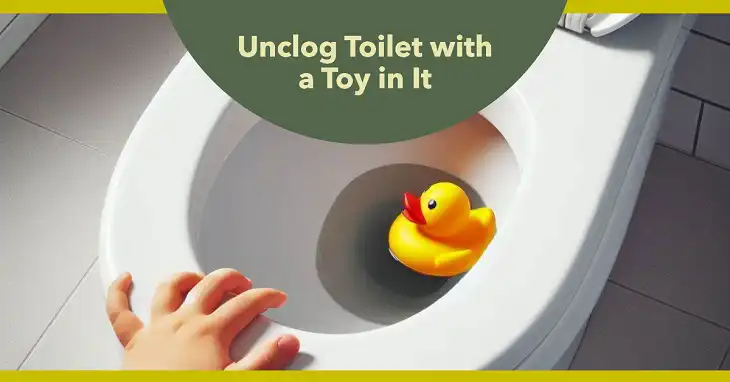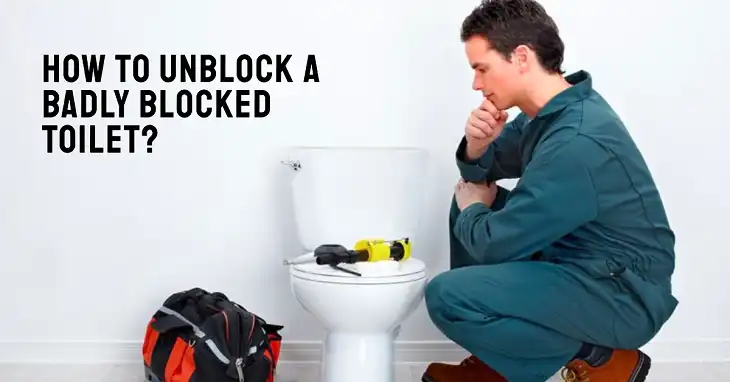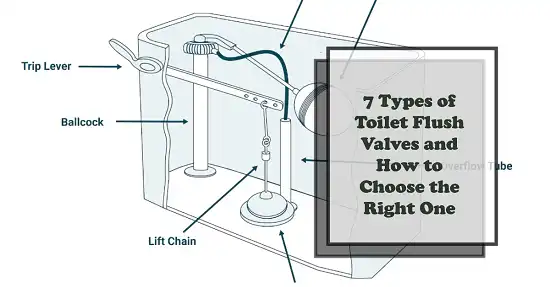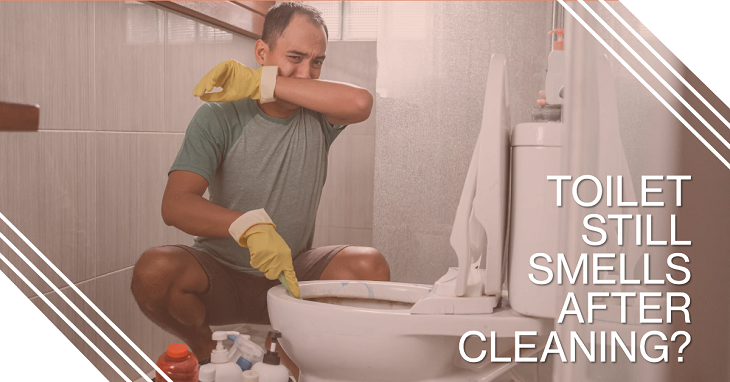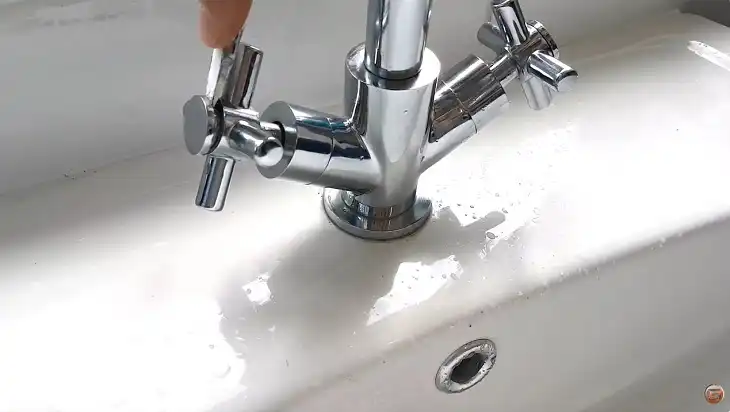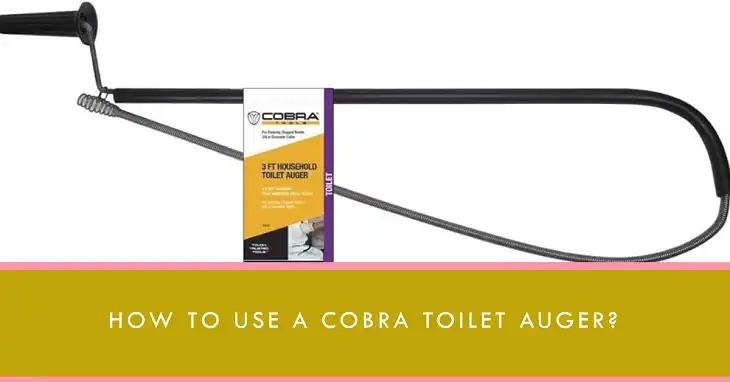15 Common Commercial Bathroom Problems and How to Fix Those
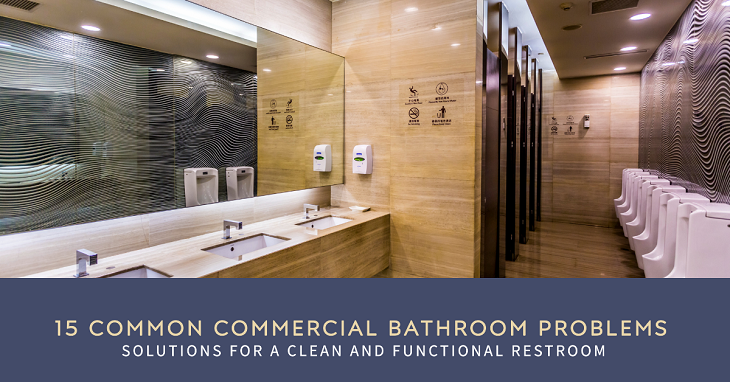
Let’s be real – having a nasty bathroom is the worst, especially for businesses. Nobody wants to walk into a pissy, smelly toilet only to be greeted by clogged sinks, busted soap dispensers, and flickering lights. It makes people never want to come back.
In this guide, we’ll break down 15 common af bathroom issues and show you how to handle that mess like a boss. We’re talking overflowing toilets, leaky faucets, busted equipment – the whole nine yards. So, without further ado, let’s begin.
Plumbing Related Issues for Commercial Toilet
Plumbing problems can be a major headache in commercial bathrooms, causing inconvenience and potentially leading to more significant issues if left unaddressed. Here are some common plumbing issues and their solutions:
Clogged Toilets

Nothing is more frustrating than encountering a clogged toilet in a commercial bathroom. This issue can be caused by improper flushing, excessive paper usage, or foreign objects being flushed down the toilet.
To resolve a clogged toilet, start by using a plunger to dislodge the blockage. Apply firm, steady plunges, allowing the plunger to create a tight seal around the toilet bowl’s drain opening. If the plunger fails to clear the clog, you may need to use a toilet auger or snake to dislodge the obstruction.
In severe cases where the clog persists, it’s advisable to call in a professional plumber. They have the expertise and specialized equipment to handle even the toughest clogs, ensuring that your toilets are back in proper working order without causing further damage.
Leaky Faucets

Leaky faucets can waste a substantial amount of water and lead to costly water bills, not to mention the annoyance of constant dripping noises. The most common causes of leaky faucets are worn washers, faulty valve seats, or corroded internal components.
To fix a leaky faucet, start by inspecting the faucet and identifying the root cause of the leak.
If the issue stems from worn washers, you may need to replace them with new ones. This is a relatively simple fix that can often be done without the need for specialized tools. However, if the valve seats or faucet cartridges are damaged or corroded, you may need to replace these components or consider replacing the entire faucet assembly.
It’s important to address leaky faucets promptly, as they not only waste water but can also lead to water damage if left unchecked. If the issue persists after your initial attempts to fix it, don’t hesitate to seek professional assistance.
Fun Fact: Did you know that a leaky faucet dripping at a rate of one drop per second can waste over 3,000 gallons of water per year? That’s enough to fill a small swimming pool!
Low Water Pressure

Low water pressure can make it difficult to flush toilets, wash hands effectively, or clean the bathroom properly. This problem could be caused by clogged aerators, partially closed shut-off valves, or a more significant issue with the building’s main water line.
When faced with low water pressure, start by inspecting and cleaning or replacing the aerators on faucets and showerheads.
Next, check the shut-off valves supplying water to the bathroom fixtures. Ensure that they are fully open and not restricted. If these steps fail to resolve the issue, it’s likely that the problem lies within the building’s main water line or the municipal water supply. In such cases, it’s best to contact a professional plumber to investigate further and recommend appropriate solutions.
Running Toilets
A running toilet can waste thousands of gallons of water annually, resulting in higher water bills and unnecessary environmental waste. This issue is often caused by a faulty flapper valve or a leaky flush valve. The flapper valve is responsible for sealing the water tank after each flush, while the flush valve controls the release of water from the tank into the bowl.
To fix a running toilet, start by inspecting the flapper valve for cracks, warping, or debris that may prevent it from sealing properly. If the flapper valve appears worn or damaged, replace it with a new one. Alternatively, you may need to adjust the flush valve chain to ensure that the flapper valve is closing properly.
If these steps don’t resolve the issue, you may need to replace the entire flush valve assembly. This is a more involved repair that may require the assistance of a professional plumber, especially if you’re unfamiliar with the specific toilet model and its components.
Dirty or Clogged Drains

Clogged drains can lead to standing water, unpleasant odors, and potential health hazards in commercial bathrooms. Hair, soap scum, and other debris can accumulate in drains over time, causing clogs that hinder proper drainage.
To clear a clogged drain, you can start by using a drain snake or a plumbing auger to dislodge the obstruction manually.
If the clog is particularly stubborn, you may need to use a commercial drain cleaner. These products contain powerful chemicals that can dissolve organic matter and break down clogs. However, exercise caution when using drain cleaners, as they can be corrosive and harmful if not used properly.
For persistent clogs or recurring issues, it may be necessary to call in a professional plumber to hydro-jet the drain lines. This process involves using high-pressure water jets to blast through and clear even the most stubborn clogs, ensuring that your drains are free-flowing and functioning optimally.
Fixtures and Functionality Issues for Commercial Toilets
Broken or missing fixtures can compromise the functionality and appearance of a commercial bathroom, leading to customer dissatisfaction and potential safety hazards. Here are some common fixture issues and their solutions:
Broken Toilet Seats

A broken or loose toilet seat can be unsanitary, uncomfortable, and potentially hazardous for users. To fix a broken toilet seat, you’ll need to replace it with a new, high-quality seat that matches the toilet’s style and color. Begin by removing the old seat according to the manufacturer’s instructions, taking note of any hardware or mounting brackets that need to be reused.
When selecting a new toilet seat, consider factors such as durability, comfort, and ease of installation. Look for seats made from solid, high-density plastic or resilient materials that can withstand heavy use. Additionally, ensure that the new seat is the correct size and shape for your toilet model to ensure a proper fit.
Follow the manufacturer’s instructions carefully during installation, paying special attention to any tightening or adjustment requirements. A properly installed toilet seat should be secure, level, and comfortable for users.
Broken Toilet Handles

A broken toilet handle can make it difficult or impossible to flush the toilet, causing frustration and potential hygiene issues. To fix this issue, you’ll need to assess whether the entire flush handle assembly needs to be replaced or if only the handle itself requires replacement.
If the handle is loose or detached but the flush mechanism appears intact, you may be able to simply replace the handle itself. Consult the toilet manufacturer’s instructions or seek assistance from a plumbing professional to ensure you select the correct replacement handle and install it properly.
However, if the flush mechanism itself is damaged or malfunctioning, you may need to replace the entire flush handle assembly. This typically involves removing the tank lid, disconnecting the existing assembly, and installing a new one according to the manufacturer’s guidelines.
In some cases, it may be more cost-effective to replace the entire toilet rather than attempting to repair or replace the flush handle assembly, especially if the toilet is older or has other underlying issues.
Missing or Damaged Paper Towel Dispensers

Paper towel dispensers are essential for maintaining proper hygiene in commercial bathrooms, as they provide a means for users to dry their hands after washing. If a dispenser is missing or damaged, it should be replaced immediately to ensure a seamless and hygienic experience for patrons.
When selecting a new paper towel dispenser, consider factors such as capacity, ease of refilling, and durability. Choose a dispenser that can accommodate the anticipated usage volume and can be easily refilled by your maintenance staff. Additionally, look for dispensers made from durable materials that can withstand heavy use and potential vandalism.
Ensure that the new dispenser matches the overall aesthetic of the bathroom and complies with any accessibility or safety regulations. Proper installation is also crucial, as a poorly mounted dispenser can become a safety hazard or be prone to tampering.
Missing or Damaged Soap Dispensers
Like paper towel dispensers, soap dispensers are crucial for promoting good hygiene practices in commercial bathrooms. Without soap, users may be unable to properly clean their hands, increasing the risk of spreading germs and illnesses.
If a soap dispenser is missing or damaged, replace it promptly with a high-quality, easy-to-refill dispenser that complements the bathroom’s design. Consider factors such as capacity, ease of refilling, and durability when selecting a new dispenser.
It’s also important to ensure that the new dispenser is compatible with the type of soap you plan to use, whether it’s liquid, foam, or bar soap. Some dispensers are designed specifically for certain soap types, so be sure to read the manufacturer’s specifications carefully.
Additionally, consider the placement and mounting of the new dispenser. It should be easily accessible to users while also being securely mounted to prevent tampering or theft.
Burned Out Light Bulbs

Burned-out light bulbs can create a dim and uninviting atmosphere in a commercial bathroom, potentially causing safety hazards and negatively impacting the overall customer experience. Replace burned-out bulbs promptly to maintain adequate lighting levels and create a welcoming environment.
When replacing light bulbs, consider switching to energy-efficient LED bulbs. LED bulbs not only provide bright, consistent illumination but also have a longer lifespan and consume less energy, reducing your overall operating costs and environmental impact.
Take note of the specific bulb type and wattage required for each fixture, as using the wrong bulb can potentially cause safety issues or premature burnout. If necessary, consult with an electrician or refer to the fixture’s manufacturer specifications to ensure you select the appropriate replacement bulbs.
Additionally, consider implementing a regular maintenance schedule to inspect and replace light bulbs proactively, rather than waiting for them to burn out completely.
Hygiene and Comfort Related Issues for Commercial Tolilets
Maintaining a clean, hygienic, and comfortable environment in commercial bathrooms is essential for ensuring customer satisfaction and promoting a positive brand image. Here are some common hygiene and comfort issues, along with their solutions:
Water Temperature Problems
Inconsistent or uncomfortable water temperatures can make hand-washing and bathing unpleasant experiences for patrons. This issue could be caused by a faulty water heater, incorrect temperature settings, or plumbing problems such as insulation issues or mineral buildup in pipes.
To resolve water temperature issues, start by checking the water heater settings and ensuring that they are set to the desired temperature. If the water heater itself appears to be malfunctioning, it may need to be repaired or replaced by a professional.
Additionally, inspect the hot water pipes for any exposed or uninsulated sections, as these can cause heat loss and contribute to temperature fluctuations. Insulating exposed pipes can help maintain consistent water temperatures throughout the bathroom.
If the problem persists, it’s possible that mineral buildup or corrosion within the plumbing lines is restricting water flow and affecting temperature consistency. In such cases, consulting a professional plumber for a thorough inspection and potential line flushing or replacement may be necessary.
Sewer Smells

Unpleasant sewer smells in a commercial bathroom can be off-putting and indicative of a more serious problem, such as a broken sewer line or a dry floor drain trap. These odors can create an unpleasant environment for patrons and negatively impact their overall experience.
To eliminate sewer smells, start by pouring water down the floor drains to refill the traps. Dry traps can allow sewer gases to escape and permeate the bathroom. Regularly pouring water down the drains can help maintain a proper water seal and prevent odors from entering.
If the sewer smell persists, it may be necessary to contact a plumber to inspect the sewer lines for potential leaks, blockages, or other issues that could be causing the odors. In some cases, replacing or repairing damaged sewer lines may be required to resolve the problem permanently.
Additionally, consider installing air fresheners or deodorizers in the bathroom as a temporary measure to help mask unpleasant odors while you address the underlying cause.
Unsanitary Conditions
Dirty floors, overflowing trash cans, and graffiti can create an unsanitary and unsightly environment in commercial bathrooms, deterring patrons and reflecting poorly on your business’s overall cleanliness and professionalism.
Regular cleaning and maintenance are essential to maintain a clean and hygienic atmosphere. Ensure that adequate cleaning supplies and equipment are available, and establish a routine cleaning schedule to keep the bathroom in top condition.
Train your janitorial staff on proper cleaning techniques and protocols, such as the use of disinfectants and scrubbing techniques for hard-to-reach areas. Encourage them to report any maintenance issues or areas that require extra attention promptly.
Additionally, consider implementing measures to prevent or discourage vandalism, such as installing graffiti-resistant surfaces or increasing security measures in high-risk areas.
Clogged Air Vents
Clogged air vents can lead to poor ventilation, odors, and moisture buildup in commercial bathrooms, creating an unpleasant and potentially unhealthy environment for patrons and staff alike.
Regularly clean and maintain the air vents to ensure proper airflow and prevent the growth of mold or mildew. Use a vacuum or duster to remove any accumulated dust, debris, or lint from the vents and surrounding areas.
If the clogging is severe or persistent, you may need to remove the vent covers and clean the ductwork more thoroughly. This process can be messy and time-consuming, so consider hiring a professional duct cleaning service if the task is beyond your in-house capabilities.
Additionally, ensure that any exhaust fans or HVAC systems serving the bathroom are functioning properly and are regularly maintained to promote adequate air circulation and ventilation.
Ineffective Exhaust Fans

Exhaust fans play a crucial role in removing moisture and odors from commercial bathrooms, helping to maintain a comfortable and fresh environment for patrons. If the exhaust fan is ineffective or not working properly, it can lead to a stuffy, humid, and unpleasant atmosphere.
Regularly inspect and maintain the exhaust fans to ensure they are operating at peak efficiency. Clean the fan blades and remove any accumulated dust or debris that may be hindering their performance.
If the fan appears to be malfunctioning or not providing sufficient airflow, it may need to be repaired or replaced. Consider upgrading to a more powerful or energy-efficient model to improve ventilation and reduce operating costs.
Additionally, ensure that the ductwork leading to and from the exhaust fan is properly installed and free from obstructions or leaks that could compromise its performance.
In some cases, it may be necessary to install additional exhaust fans or increase the overall ventilation capacity of the bathroom, particularly in high-traffic or humidity-prone areas.
End Notes
Keeping a clean, functional commercial bathroom is so key for customer satisfaction. Stay on top of maintenance, have a process for handling issues promptly, and your bathrooms will be a welcome oasis instead of a horrific chamber.
If anything still seems unclear or you need specific advice, hit me up in the comments below. I’m here to help keep your bathroom game strong!

